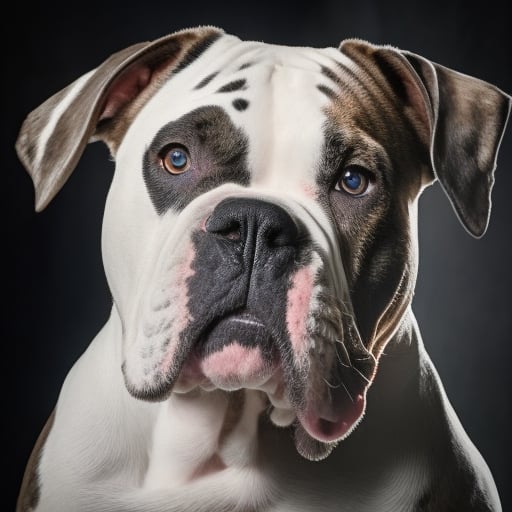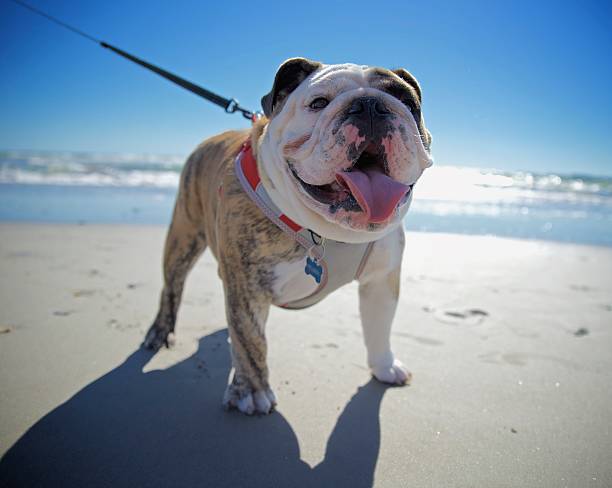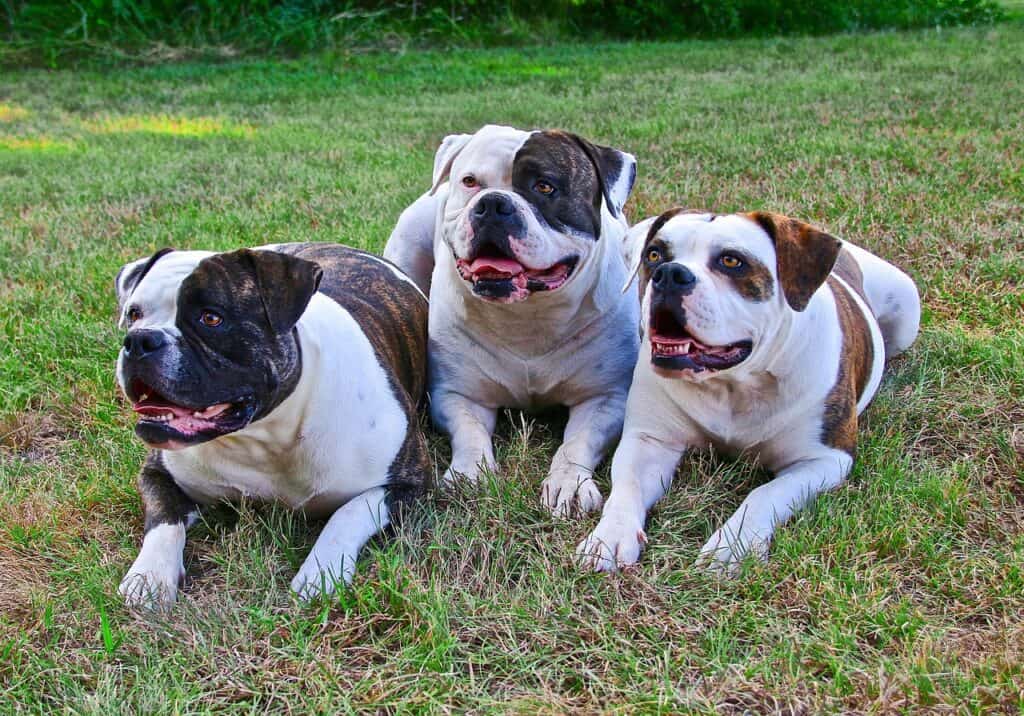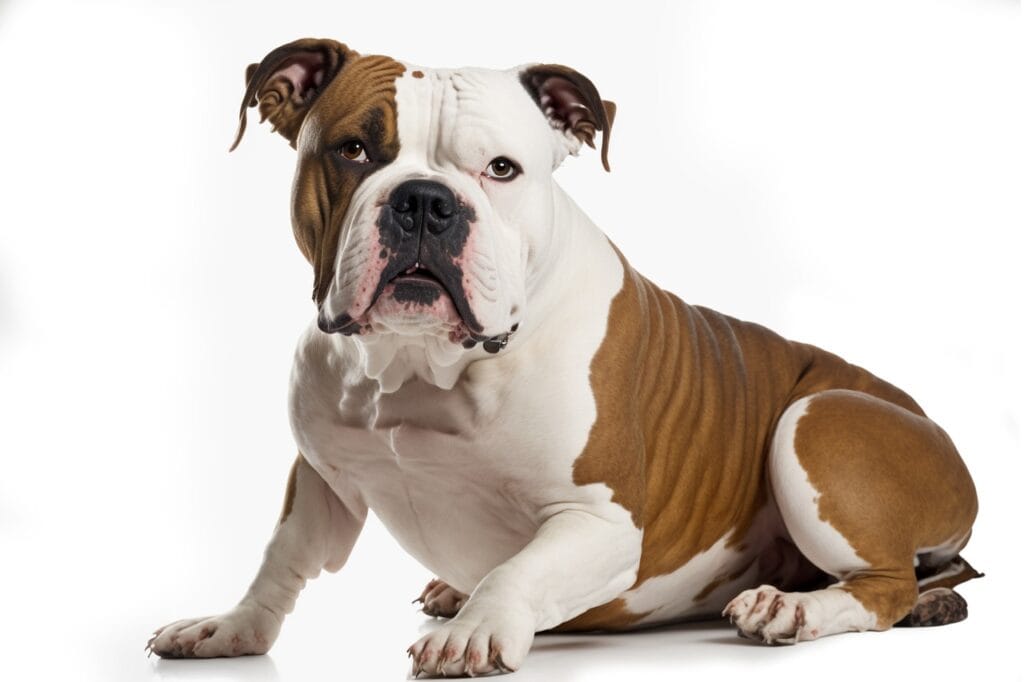The American Bulldog, a beloved symbol of strength, loyalty, and rugged charm, holds a special place in the hearts of dog enthusiasts and families alike. With its rich history, distinctive appearance, and unique personality traits, this breed has earned its status as a cherished companion and working dog.

| Category (Explanation) | Breed Information |
|---|---|
| Year of Breed Conception | 1940s-1950s |
| Country of Origin | United States |
| Weight (lbs & kg) (Male) | 75-120 lbs (34-54 kg) |
| Weight (lbs & kg) (Female) | 60-100 lbs (27-45 kg) |
| Coat Type | Short |
| Color Variations | White with patches of brindle, red, or brown |
| Shedding Level (Low, Moderate, High) | Moderate |
| Height (cm & in) | 20-28 inches (51-71 cm) |
| Breed Size | Large |
| Trainability (Low, Moderate, High) | Moderate |
| Mental Needs (Low, Moderate, High) | Moderate |
| Intelligence Level (Low, Moderate, High) | Moderate |
| Energy Level (Low, Moderate, High) | Moderate |
| Agility (Low, Moderate, High) | Moderate |
| Loyalty (Low, Moderate, High) | High |
| Playfulness (Low, Moderate, High) | Moderate |
| Exercise Needs | Regular exercise and playtime |
| Guarding Proficiency (Low, Moderate, High) | Moderate |
| Sociability with Children (Low, Moderate, High) | High |
| Barking Level (Low, Moderate, High) | Moderate |
| Digging Tendency (Low, Moderate, High) | Moderate |
| Destructive Behavior (Low, Moderate, High) | Low |
| Drooling Level (Low, Moderate, High) | Low |
| Obedience Level (Low, Moderate, High) | Moderate |
| Apartment Friendly (Yes/No) | Can adapt to apartment living |
| Inherent Prey Drive | Moderate |
| Physical Risk to Others (Low, Moderate, High) | Low |
| Travel Fatality Risk (Low, Moderate, High) | Low |
| Allergen Potential | Low (considered hypoallergenic) |
| Health Concerns (List of Common Health Concerns) | Hip Dysplasia, Skin Issues, Eye Problems, ACL Injuries |
| Average Life Expectancy (Life Expectancy in Years) | 10-16 years |











































































Woof Mastery is reader supported and our articles may contain affiliate links.
Instead of running third party ads that we have no control of we only use links from high-quality companies we are directly partnered with. Making use of these links come at no cost to you our reader, and in many cases have the extra benefit of discounted rates or sign up bonuses.
If you’re interested you can read more about our affiliate policy here.
We appreciate your support and always insure that the products and services we recommend are high-quality, helpful and relevant to the subject at hand!
The American Bulldog’s origin and history are a testament to the enduring spirit of these remarkable dogs. Rooted in the early days of American colonization, these canines were brought to the New World by European settlers in the 17th century. These working bulldogs were cherished for their versatility, assisting in hunting, guarding, and farm work.
Over the centuries, American Bulldogs played crucial roles in helping settlers establish their homes and livelihoods. Their physical prowess, determination, and unwavering loyalty made them indispensable companions. They became known for their unyielding courage, even in the face of formidable challenges.
In the mid-20th century, two breed enthusiasts, John D. Johnson and Alan Scott, dedicated themselves to preserving and refining the American Bulldog breed. Their efforts led to the modern breed we know today. Johnson focused on the “bully” type, emphasizing strength and athleticism, while Scott concentrated on the “standard” type, prioritizing working ability and intelligence.
Through their dedication and careful breeding, Johnson and Scott revived the American Bulldog, establishing breed standards and ensuring its recognition as a distinct breed. Today, the American Bulldog stands as a testament to the enduring legacy of these courageous, loyal, and resilient dogs, embodying the spirit of the American frontier and the heart of countless families across the nation.

What sets the American Bulldog apart is its unique blend of strength and affection. This breed’s powerful physique and unwavering loyalty make it an exceptional guardian and working dog.
Yet, beneath its rugged exterior lies a heart full of devotion, making it a cherished family companion. Its history of resilience and its ability to balance protective instincts with gentle companionship make the American Bulldog truly special.
The American Bulldog’s traditional role in human society traces back to early American colonization when European settlers brought their working bulldogs to the New World. These sturdy canines played multifaceted roles in daily life, excelling as guardians of farms and homesteads.
Their strength and tenacity made them invaluable for hunting, herding livestock, and protecting families from wild predators. Over the years, their unwavering loyalty and courage earned them a reputation as reliable and fiercely protective working dogs.
This enduring legacy of dependability and resilience continues today, as American Bulldogs remain beloved family companions and capable working dogs, embodying the spirit of America’s frontier heritage.
American Bulldogs are renowned for their distinctive personalities. They are known to be fiercely loyal, deeply affectionate, and incredibly protective of their families.
Despite their imposing appearance, they often possess a gentle and affectionate disposition, particularly with children. Their innate intelligence, coupled with a determined spirit, makes them highly trainable and versatile. While they can be reserved with strangers, they are fiercely devoted to their owners. American Bulldogs are characterized by their confidence, courage, and an unwavering sense of duty.
With the right training and socialization, they can be loving, loyal, and dependable companions, epitomizing the perfect blend of strength and affection.
Despite usually being loving and loyal, their protective instincts, if not properly managed through training and socialization, can lead to overprotectiveness and aggression towards strangers.
This breed may display territorial behavior, and they can be stubborn at times, requiring consistent and patient training. Their strength and size can pose challenges if not adequately controlled, making leash training crucial. Additionally, they may not always get along with other dogs, particularly of the same sex, necessitating careful introductions.
While affectionate with their families, some American Bulldogs can display dominance tendencies, making early training and socialization critical to fostering a well-adjusted temperament.
American Bulldogs are robust, medium to large-sized dogs with a powerful and athletic build. They have a square-shaped, broad head, which is more pronounced in males, and their distinctive facial features include a wide, well-defined jaw and strong, muscular cheeks.
Their eyes are almond-shaped and typically come in various shades of brown. Ears may be natural, semi-pricked, or cropped, depending on preference and regional regulations.
These dogs have a short, dense coat that lies close to their skin, usually in shades of white with patches of brindle, red, or brown. Their skin is thick and loose, especially around the neck, giving them a wrinkled appearance, which is more prominent in males.
The American Bulldog’s neck is muscular, leading to a broad chest and sturdy, straight legs. Their tail is often straight and tapered.
In terms of size, males typically stand between 22 to 28 inches (56-71 cm) at the shoulder and have a more substantial build, while females are slightly smaller and have a more refined physique. Weight can range from 60 to 120 pounds (27-54 kg) for males and is generally lighter for females.
Overall, American Bulldogs have well-proportioned, agile bodies, reflecting their history as working dogs. Their appearance exudes strength, confidence, and athleticism, with males showcasing a more robust and imposing presence compared to females.
American Bulldogs come in various color variations, adding to their unique and distinctive appearance. The most common color variations for American Bulldogs include:
Solid White: While less common, some American Bulldogs may have an entirely white coat with no patches or markings. These dogs have a clean, all-white appearance.
Brindle: This is one of the most common coat patterns in American Bulldogs. Brindle patterns consist of dark stripes or streaks (typically brown or black) on a lighter background color, often white. The brindle pattern can vary in intensity and distribution.
Pied: Pied patterns are characterized by scattered patches of color on a predominantly white coat. These patches may vary in size and shape.
American Bulldogs have a moderate shedding level. While they are not considered heavy shedders like some other breeds, they do shed year-round, and shedding tends to increase during seasonal changes, such as spring and fall. The degree of shedding can vary from one individual to another.
Factors influencing shedding in American Bulldogs include genetics, health, and the quality of their coat. Regular grooming can help manage shedding by removing loose fur and promoting a healthier coat. Brushing your American Bulldog once or twice a week with a bristle brush or a deshedding tool can help keep shedding under control.
American Bulldogs have short, dense coats that lie close to their skin. This short coat is relatively easy to maintain and does not require extensive grooming.
Brushing: Regular brushing, about once or twice a week, is usually sufficient to keep their coat healthy and minimize shedding. A bristle brush or a deshedding tool can help remove loose fur and distribute natural oils for a shiny coat.
Bathing: American Bulldogs do not require frequent baths unless they get exceptionally dirty. Over-bathing can strip their skin of essential oils. Use a mild dog shampoo when necessary, and be sure to thoroughly rinse and dry them afterward.
Ears: Check and clean their ears regularly to prevent wax buildup or infections. Use a damp cotton ball or a veterinarian-recommended ear cleaning solution.
Nails: Keep their nails trimmed to a comfortable length, as long nails can cause discomfort and affect their gait.
Teeth: Oral hygiene is essential. Brush their teeth regularly to prevent dental issues and bad breath. Dental chews or toys can also help.
Wrinkle Care (if applicable): If your American Bulldog has wrinkles, such as around the face or neck, ensure that these areas are kept clean and dry to prevent skin issues. Gently clean and dry between the folds as needed.
Eye Care: Keep an eye on their eyes for signs of irritation or discharge. If necessary, use a damp cloth to clean around the eye area.
American Bulldogs have a moderate activity level. While they are not as hyperactive as some other breeds, they do require regular exercise to stay healthy and happy. Here are some key points to consider about their activity level:
Age Consideration: As American Bulldogs age, their activity level may decrease, and their exercise requirements may change. Tailor their exercise routine to their age and individual needs.
American Bulldogs are considered to be moderately intelligent dogs. Their intelligence is characterized by a combination of problem-solving abilities, adaptability, and a strong desire to please their owners. Here are some key points about their intelligence:
While American Bulldogs may not rank among the top breeds in terms of problem-solving or obedience, their intelligence is more than sufficient for being excellent companions and working dogs. Training, socialization, and mental stimulation are essential to help them reach their full potential and become well-rounded and obedient pets.
American Bulldogs thrive on mental stimulation. Engage them in activities that challenge their minds, such as puzzle toys, obedience training, or interactive games.
Social Interaction: They are social dogs and need regular interaction with their human family members. Loneliness can lead to anxiety or depression, so provide them with companionship and attention.
Exercise: Physical activity is not just for their bodies; it also benefits their mental health. Regular exercise helps reduce stress and anxiety.
Training and Obedience: American Bulldogs benefit from obedience training, which not only provides mental stimulation but also reinforces their bond with their owners. Consistent, positive-reinforcement training is effective in shaping their behavior.
Routine and Structure: Dogs, in general, thrive on routine and structure. Establishing a predictable daily routine can help them feel secure and reduce anxiety.
Affection and Attention: Show affection and spend quality time with your American Bulldog. They are known for their loyalty and need for human companionship.
Socialization: Early socialization is crucial to help them become well-adjusted dogs. Expose them to different people, animals, and environments to build their confidence.
Safe Environment: Create a safe and comfortable environment at home where they can relax and feel secure. Provide a designated space for them to retreat to if they need alone time.
Consistency: Consistency in training and daily routines helps them feel more secure and confident in their environment.
Enter The Woof Mastery

Before bringing an American Bulldog into your home, it’s crucial to understand their needs. These dogs require regular exercise and socialization, making them unsuitable for inactive lifestyles. Training and socialization are vital to harness their strong, protective instincts.
Health concerns, like hip dysplasia, need monitoring. Potential owners should be prepared for grooming and be aware of breed-specific laws in their area. Responsible ownership includes providing ample love, attention, and a safe environment to ensure the well-being of these loyal, energetic companions.
American Bulldogs, like any large and strong breed, have the potential to pose a physical danger to other people if they are not properly socialized, trained, or managed. It’s essential to note that a dog’s behavior largely depends on factors such as individual temperament, upbringing, training, and the owner’s responsibility. Here are some considerations regarding their potential physical danger:
While American Bulldogs are often known for their affectionate and protective nature towards children, making them good family pets. However, their interactions with children should always be supervised, especially with young children, as with any breed of dog. Here are some considerations regarding American Bulldogs and their behavior with children:
American Bulldogs are generally capable swimmers, but like all dogs, their swimming ability can vary from one individual to another. Here are some factors to consider regarding their ability to swim:
While many American Bulldogs can swim and may enjoy the water, it’s important to gauge your individual dog’s comfort level and abilities. If you plan to introduce your American Bulldog to swimming, do so in a safe and controlled environment, and always prioritize their safety and well-being.
Remember that American Bulldog puppies, like all puppies, are eager to please and learn. Positive and consistent training practices will help them become well-behaved, obedient, and happy adult dogs. Building a strong and trusting bond with your puppy through training is a rewarding experience for both you and your canine companion.
American Bulldogs, like all dogs, can produce various noises and vocalizations as part of their communication and daily activities. Here are some common noises they may make:
It’s important for owners to pay attention to their American Bulldog’s vocalizations and understand the context in which they occur. While some noises are normal and harmless, others may indicate discomfort or a need for attention. Positive reinforcement training can help manage and modify their vocal behaviors as needed.
American Bulldogs thrive in homes with active families, space to move, socialization opportunities, and a structured routine. They may face challenges in situations where their exercise and socialization needs are not met, or in extreme weather conditions. Proper care, training, and attention to their unique requirements contribute to their well-being and happiness.
Challenges:
When it comes to travel fatality risk for American Bulldogs, consider the following potential constraints:
By addressing these potential constraints and taking necessary precautions, you can help ensure the safe travel of your American Bulldog and minimize travel-related risks.
American Bulldogs may be prone to specific health concerns. While not all individuals will experience these issues, it’s essential for American Bulldog owners to be aware of potential health problems and work with veterinarians to maintain their pets’ well-being. Common health concerns in American Bulldogs include:
Regular veterinary check-ups, a balanced diet, proper exercise, and responsible breeding practices can help mitigate some of these health concerns. It’s crucial for American Bulldog owners to work closely with their veterinarians to monitor their pets’ health and address any issues promptly.
Proper nutrition is crucial for the health and well-being of American Bulldogs. Here are some nutritional habits and best practices to consider for this breed:
Breed-Specific Laws (BSL): American Bulldogs may be subject to breed-specific laws (BSL) in certain areas. These laws are often enacted at the local or municipal level and can vary widely from one jurisdiction to another.
Types of Restrictions: The specific restrictions imposed on American Bulldogs under BSL can include mandatory spaying/neutering, special licensing, liability insurance requirements, muzzling in public, and, in some cases, bans on ownership. The severity of these restrictions depends on local regulations.
Rationale for BSL: BSL is typically implemented based on concerns about public safety and perceived risks associated with specific breeds, often due to incidents involving dog attacks. While American Bulldogs are not inherently aggressive, they can be affected by BSL due to their physical resemblance to breeds that are sometimes included in these laws.
Controversy: It’s important to note that BSL is a controversial topic. Critics argue that it unfairly targets breeds rather than addressing individual dog behavior and that responsible ownership and training should be emphasized instead of breed-specific restrictions.
Local Regulations: To determine if there are breed-specific laws or restrictions regarding American Bulldogs in your area, you should check with your local animal control or government authorities. Be aware of and comply with any local regulations to ensure that you are in compliance with the law while owning an American Bulldog.
Woof Mastery is reader supported and our articles may contain affiliate links.
Instead of running third party ads that we have no control of we only use links from high-quality companies we are directly partnered with. Making use of these links come at no cost to you our reader, and in many cases have the extra benefit of discounted rates or sign up bonuses.
If you’re interested you can read more about our affiliate policy here.
We appreciate your support and always insure that the products and services we recommend are high-quality, helpful and relevant to the subject at hand!
Myth 1: American Bulldogs are Aggressive by Nature
Myth 2: They are Only Suitable for Experienced Owners
Myth 3: They are the Same as Pit Bulls
Myth 4: They are Not Good with Children
Myth 5: American Bulldogs Cannot Live in Apartments
Myth 6: They are Low in Intelligence
Myth 7: They are Always Aggressive Towards Other Dogs
Myth 8: They are All the Same
Myth 9: They Don’t Need Exercise
Myth 10: They are Not Good Family Dogs
These myths highlight the importance of understanding individual dog behavior and considering factors like socialization and training. American Bulldogs can make wonderful, loyal companions when they receive proper care and responsible ownership.
These famous Bulldogs have left their mark on history, whether through sports mascot traditions or their heroic service in wartime, and they continue to be celebrated symbols in their respective contexts.
The American Bulldog holds cultural significance in various contexts:
While there may not be as many famous American Bulldog owners as there are for other dog breeds, here are a few notable individuals who have been associated with American Bulldogs:
American Bulldogs, like many other dog breeds, have faced several threats and challenges over the years. Some of the significant threats and issues that have affected the breed include:
The American Bulldog is believed to have been developed from a combination of various breeds, with the primary ancestors being the Old English Bulldog and various Mastiff-type dogs. The breed’s development occurred over several centuries, with influences from different regional strains and breed types. The specific breeds and strains that contributed to the American Bulldog’s development include:
American Bulldogs epitomize the essence of cherished family companions. With their unwavering loyalty and affection, they seamlessly integrate into our lives, providing not only security but also heartfelt devotion. As excellent watchdogs, their protective instincts further solidify their role as guardians of our homes.
Their gentle and patient nature makes them perfect playmates for families with children, adapting effortlessly to various living conditions while demanding only minimal grooming. Their athletic prowess caters to active individuals and families, and their innate intelligence allows them to shine in activities and training.
Beyond their physical attributes, American Bulldogs bring a unique charm to every household, filling the air with their playful presence. Their versatility is a testament to their adaptability, transitioning effortlessly from beloved family pets to diligent working dogs.
Above all, these dogs offer an unparalleled gift—profound and unconditional love. They become more than pets; they become treasured family members, enriching our lives with their unwavering companionship and forging an unbreakable bond that lasts a lifetime.
Now, we invite you to discover the incredible love and devotion that this remarkable breed has to share. Bring an American Bulldog into your lif